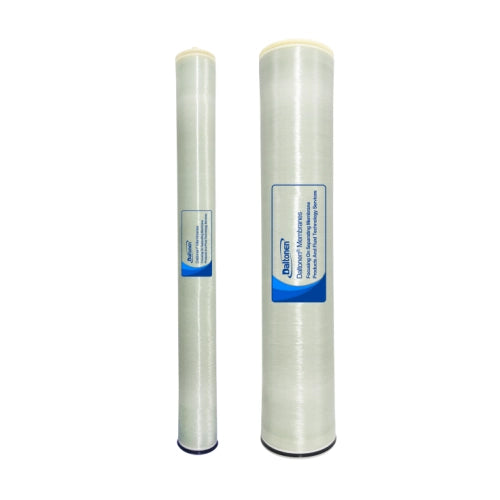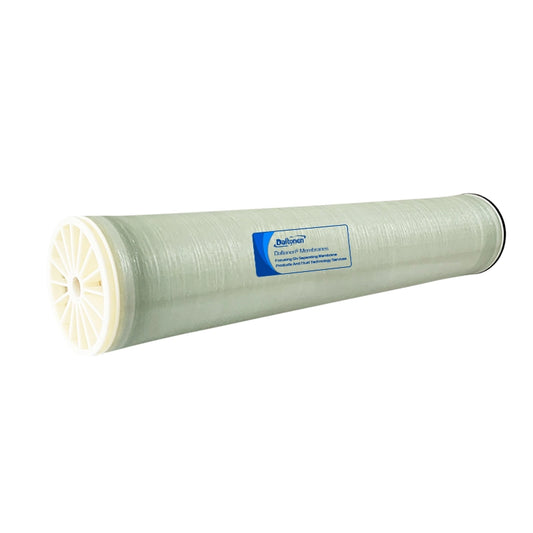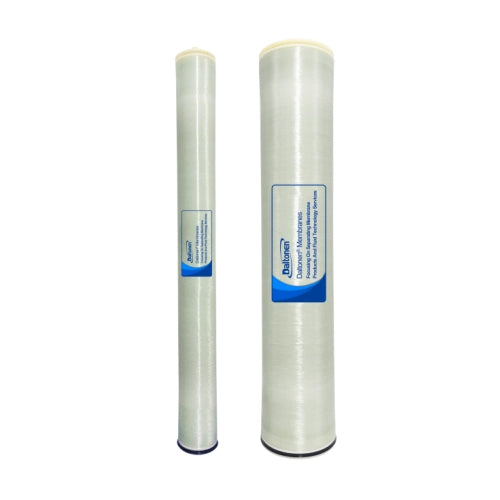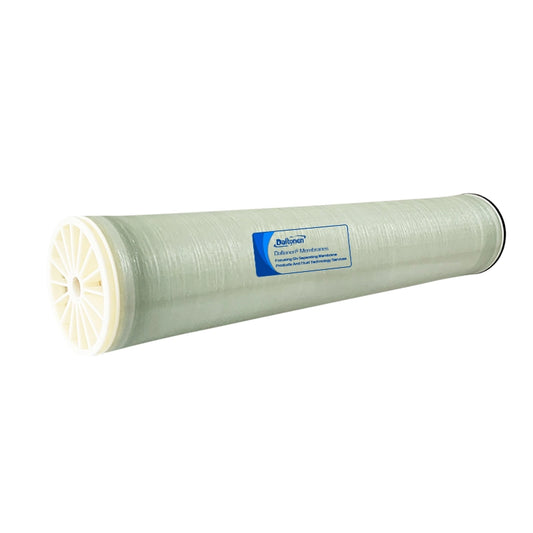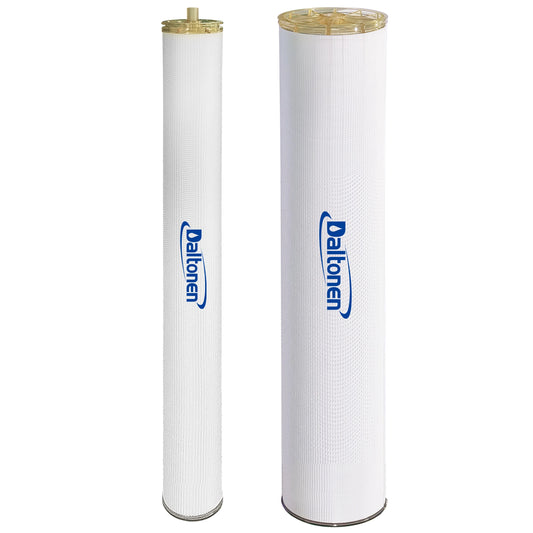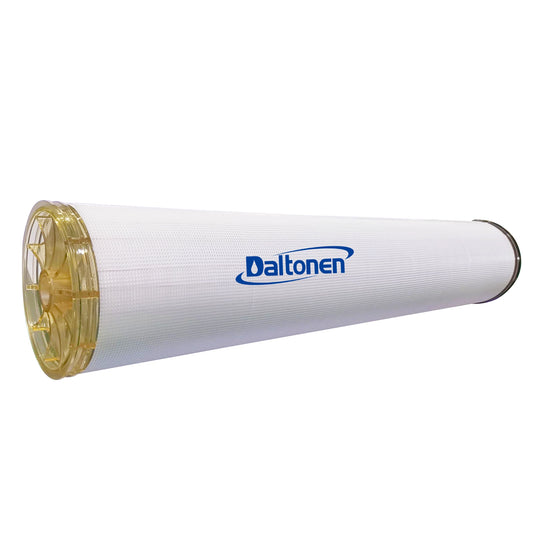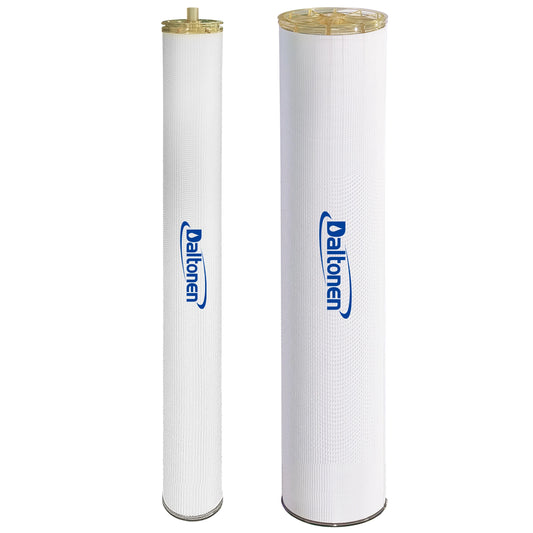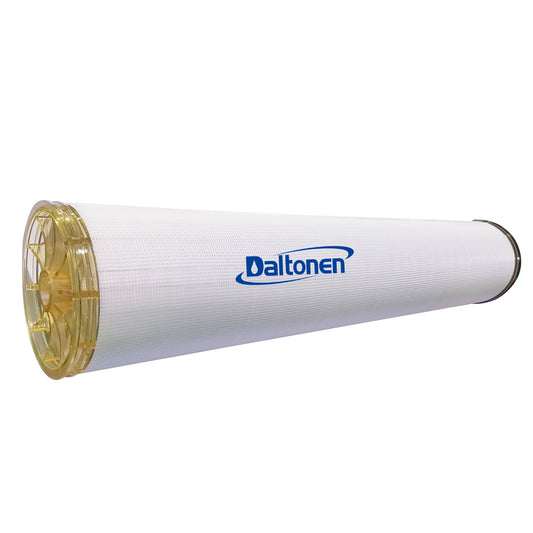The Effect of Temperature on the Water Permeability of RO Membranes
The Effect of Temperature on the Water Permeability of RO Membranes
1.1 Mechanisms of Temperature's Impact on Water Production
Temperature has a significant impact on the water production of RO membranes, mainly reflected in the following aspects:
- Water Molecule Diffusion Rate: As temperature increases, the movement speed of water molecules accelerates, and their diffusion capability enhances, making it easier for them to pass through the RO membrane. Research indicates that generally, for every 1°C increase in water temperature, the diffusion coefficient of water molecules increases by 2% to 3%, which leads to an increased membrane permeation rate and consequently, an increase in the water production of the RO membrane. For instance, in one experiment, increasing the feed water temperature from 20°C to 30°C resulted in a 30% increase in the water production of the RO membrane.
- Membrane Pore Structure Changes: Some RO membrane materials undergo thermal expansion when the temperature rises, leading to an increase in membrane pore size. Although the change is minimal, the slight increase in pore diameter reduces the resistance for water molecules to pass through the membrane, further promoting an increase in water production. However, it is important to note that different membrane materials have different coefficients of thermal expansion, and the degree of this impact varies.
- Feed Water Viscosity Changes: As water temperature increases, the viscosity of the feed water decreases. Viscosity is negatively correlated with water production; a decrease in viscosity means reduced resistance for water flow at the membrane surface, allowing water to pass through the membrane more smoothly, thereby increasing water production. Data shows that as water temperature rises from 5°C to 25°C, the viscosity of water decreases from 1.52×10⁻³ Pa·s to 0.89×10⁻³ Pa·s, and water production can increase by about 40%.
- Changes in Membrane Material Properties: High temperatures can affect certain physical and chemical properties of RO membrane materials, such as hydrophilicity and surface charge. These changes in properties can indirectly affect the interaction between water molecules and the membrane, thereby influencing water production. For example, when the temperature rises, the hydrophilicity of the membrane surface may enhance, aiding in the adsorption and permeation of water molecules, resulting in increased water production.

1.2 The Impact of Temperature on Water Molecule Viscosity
The effect of temperature on water molecule viscosity is one of the key factors in changing the water production of RO membranes:
- Mechanism of Viscosity Reduction: As temperature increases, the thermal motion of molecules intensifies, the distance between molecules increases, and the intermolecular forces weaken. The cohesive forces between water molecules (such as hydrogen bonds and van der Waals forces) are partially overcome at high temperatures, reducing the frictional resistance between molecules, leading to a decrease in water viscosity. The reduction in viscosity thins the laminar boundary layer at the membrane surface, allowing water molecules to approach and pass through the membrane more easily, thereby increasing water production.
- Actual Impact Data: According to experimental data, the viscosity of water changes significantly at different temperatures, and the trend is consistent with the changes in water production. For example, in one study, as water temperature increased from 10°C to 30°C, the viscosity of water decreased from 1.30×10⁻³ Pa·s to 0.80×10⁻³ Pa·s, and the water production of the RO membrane increased from 30 liters per hour to 50 liters per hour, showing a clear negative correlation with viscosity changes.
- Comparison with Other Factors: Compared to other factors such as surface tension and osmotic pressure, the change in water molecule viscosity has a more significant impact on the water production of RO membranes. In most cases, the reduction in viscosity contributes the most to the increase in water production, while the effects of surface tension and osmotic pressure are relatively smaller.
2.The Impact of Temperature on the Desalination Performance of RO Membranes
2.1 Mechanisms of Temperature's Impact on Desalination Rate
Temperature has a significant impact on the desalination rate of RO membranes, mainly reflected in the following aspects:
- Solvent Diffusion Rate Changes: As temperature increases, the thermal motion of solute molecules accelerates, and their diffusion coefficients increase, leading to faster migration of solute molecules within the membrane. This allows some solute molecules to pass through the RO membrane more easily, resulting in an increase in solute concentration on the product water side, thereby reducing the membrane's desalination rate. According to the Arrhenius equation, the diffusion coefficient of solute molecules is exponentially related to temperature, and for every 10°C increase in temperature, the diffusion coefficient approximately doubles, leading to a corresponding decrease in desalination rate.
- Changes in Membrane-Solute Interactions: The increase in temperature affects the interactions between RO membrane materials and solute molecules, such as van der Waals forces and electrostatic forces. For example, when the RO membrane surface carries a negative charge, an increase in temperature may lead to changes in the surface charge density, weakening its electrostatic repulsion against charged solutes (such as ions), allowing some solutes to pass through the membrane more easily, thereby reducing the desalination rate. Research data indicates that under certain conditions, for every 1°C increase in temperature, the desalination rate may decrease by 0.5% to 1%.
- Impact on Membrane Structural Stability: Under high-temperature conditions, the structural stability of RO membranes may be challenged. Some membrane materials are prone to thermal degradation or structural reorganization at high temperatures, leading to an increase in membrane pore size or membrane layer separation, which results in poorer solute retention and a decrease in desalination rate. For example, one study found that the desalination rate of certain RO membranes drops sharply at temperatures above 40°C, far below the performance indicators at 25°C.
2.2 The Impact of Temperature on Solute Permeability
The impact of temperature on the solute permeability of RO membranes is significant, specifically manifested as follows:
- Increased Permeability: Overall, as temperature increases, the solute permeability of RO membranes tends to rise. This is due to the accelerated diffusion rate of solute molecules and changes in membrane-solute interactions, which together allow more solute molecules to pass through the RO membrane. Experimental data shows that within the temperature range of 20°C to 40°C, the permeability of RO membranes to common solutes such as NaCl can increase by 20% to 50%.
- Differences in Permeability of Different Solutes: Different types of solute molecules respond differently to temperature changes, and the extent to which their permeability varies with temperature will also differ. For example, for some larger organic molecules or complex ionic compounds, an increase in temperature may cause changes in their molecular structure or enhance intermolecular interactions, thereby affecting their ability to pass through the RO membrane. In contrast, small inorganic salt solutes such as NaCl and MgSO4 are more significantly affected by temperature in terms of their permeability.
- Impact in Practical Applications: In water treatment processes, the impact of temperature on solute permeability directly relates to the quality of the product water. For example, in seawater desalination applications, if an increase in temperature leads to a decrease in desalination rate, it may cause the salt content of solutes such as NaCl in the product water to exceed standards, affecting the usability of the product water. Therefore, in actual operations, it is usually necessary to reasonably control the feed water temperature according to specific water treatment requirements and the performance characteristics of the RO membrane to ensure that the product water quality meets the expected standards.
3.The Impact of Temperature on the Operating Pressure of RO Membranes
3.1 Changes in Operating Pressure under High and Low Temperature Conditions
The impact of temperature on the operating pressure of RO membranes is multifaceted, specifically manifested in the following aspects:
3.1.1 Changes in Operating Pressure under High Temperature Conditions
- Increased Osmotic Pressure: Under high-temperature conditions, the concentration difference between the solutions on both sides of the RO membrane remains relatively stable, but due to the reduced viscosity of water and the enhanced diffusion capability of water molecules, the membrane's osmotic pressure increases. Osmotic pressure is the driving force that pushes water molecules from the high-concentration side to the low-concentration side, and an increase in osmotic pressure requires higher operating pressure to overcome this resistance, thereby achieving the same water production. For example, within the temperature range of 25°C to 40°C, for every 1°C increase, the osmotic pressure may increase by 0.2% to 0.5%.
- Membrane Structural Changes: Some RO membrane materials undergo thermal expansion at high temperatures, with slight adjustments in membrane pore structure, which may lead to increased membrane resistance, thereby requiring higher operating pressure to maintain water production. At the same time, high temperatures can accelerate the aging of membrane materials, reducing their structural stability and increasing their compressibility, making it difficult to achieve the expected water production under the same pressure, further necessitating an increase in operating pressure
.
- Accelerated Solute Diffusion: An increase in temperature causes solute molecules to diffuse more quickly, making it easier for them to penetrate the RO membrane, resulting in an increase in solute concentration on the product water side. To maintain a high desalination rate, higher operating pressure is needed to enhance the retention of solute molecules. For example, when treating brackish water with high salt content, increasing the temperature from 25°C to 35°C may require a 10% to 15% increase in operating pressure to maintain a desalination rate of over 99%.
3.1.2 Changes in Operating Pressure under Low Temperature Conditions
- Decreased Osmotic Pressure: At low temperatures, the diffusion capability of water molecules weakens, resulting in relatively low osmotic pressure. To achieve the expected water production, higher operating pressure is needed to overcome the lower osmotic pressure, thereby promoting more water molecules to pass through the RO membrane. For example, within the temperature range of 5°C to 20°C, for every 1°C decrease, the operating pressure may need to increase by 0.3% to 0.8% to maintain stable water production.
- Membrane Pore Contraction: Under low-temperature conditions, some RO membrane materials may undergo thermal contraction, leading to smaller membrane pores. This contraction increases the resistance for water molecules to pass through the membrane, so higher operating pressure is needed to maintain water production. At the same time, the elastic modulus of the membrane typically increases at low temperatures, making the membrane less deformable under pressure, further requiring an increase in pressure to overcome this resistance.
- Increased Water Viscosity: At low temperatures, the viscosity of water increases, and the flow resistance of water at the membrane surface also increases. To push the water flow through the RO membrane smoothly, higher operating pressure is needed to overcome this resistance, thereby achieving the expected water production. For example, as water temperature drops from 10°C to 5°C, the viscosity of water increases from 1.31×10⁻³ Pa·s to 1.52×10⁻³ Pa·s, and to maintain the same water production, the operating pressure may need to be increased by 10% to 20%.
3.1.3 Comprehensive Impact of Temperature Changes on Operating Pressure
- System Design Adjustments: In the actual design of RO systems, measures are usually taken to address the impact of temperature changes on operating pressure. For example, under high-temperature conditions, it may be necessary to add pressure regulation devices or use heat-resistant membrane materials to ensure that the system can operate stably under different temperature conditions. Under low-temperature conditions, it may be necessary to configure heating equipment to preheat the feed water to a suitable range in advance, reducing the demand for operating pressure.
- Operation Optimization Strategies: In the operation of RO systems, operating pressure can be dynamically adjusted according to temperature changes. By monitoring the feed water temperature and water production in real-time, the operating pressure can be gradually increased in low temperatures and appropriately decreased in high temperatures, combined with other operating parameters (such as recovery rate, feed water pH value, etc.) for comprehensive optimization, to achieve the best water treatment effect.
- Equipment Selection Basis: When selecting equipment for RO systems, it is also necessary to consider the impact of temperature on operating pressure. For example, the selection of high-pressure pumps should not only meet the operating pressure requirements of the system under normal temperature conditions but also consider the highest operating pressure that may be needed under extreme temperature conditions (such as high or low temperatures) to ensure the reliability of the equipment and the stability of the system.

4.The Long-Term Impact of Temperature on the Life and Stability of RO Membranes
4.1 The Impact of Temperature on the Mechanical Strength and Chemical Stability of RO Membranes
- Long-Term Impact on Mechanical Strength: Temperature has a significant long-term impact on the mechanical strength of RO membranes. High temperatures can cause RO membrane materials to undergo thermal expansion, and if this expansion is uneven, it can lead to internal stress within the membrane. Over time, the accumulation of these stresses may cause cracks or deformation in the membrane. For example, some thermoplastic membrane materials have their tensile strength gradually reduced in continuous high-temperature environments, making the membrane structure more fragile, and it is prone to mechanical damage under external force impact or pressure fluctuations, thereby shortening the membrane's service life. Data shows that under high-temperature conditions, the rate of decline in the mechanical strength of RO membranes is usually 2 to 3 times faster than at normal temperatures.
- Long-Term Impact on Chemical Stability: Long-term operation under high-temperature conditions also challenges the chemical stability of RO membranes. High temperatures can accelerate the reaction rate between membrane materials and chemical substances in water (such as dissolved oxygen, chlorine, etc.), leading to chemical degradation reactions of the membrane materials such as oxidation and hydrolysis. Taking polyamide composite membranes as an example, for every 10°C increase in temperature, the rate of oxidation degradation may increase by 2 to 3 times, which can change the surface properties and pore structure of the membrane, reducing its separation performance. At the same time, high temperatures can also promote the deposition of some chemical substances on the membrane surface, further accelerating membrane pollution and aging, affecting the long-term stability of the membrane.
4.2 The Repeated Impact of Temperature Fluctuations on RO Membrane Performance
- Cumulative Effect of Performance Fluctuations: Frequent temperature fluctuations can cause repeated changes in RO membrane performance, and this cumulative effect can have an adverse impact on the membrane's life. When the temperature rises, the membrane's water production increases and the desalination rate decreases; when the temperature drops, the water production decreases and the desalination rate increases. This repeated performance fluctuation causes continuous stress changes within the membrane material, gradually leading to fatigue damage. For example, after some membrane materials experience multiple temperature cycles, their ability to recover water production and desalination rate is significantly reduced, and even irreversible performance loss may occur, ultimately shortening the membrane's service life.
- Long-Term Changes in Membrane Surface Properties: Temperature fluctuations can also have a long-term impact on the surface properties of RO membranes. Under different temperature conditions, the hydrophilicity and charge distribution of the membrane surface can change. For example, the hydrophilicity of the membrane surface may increase at high temperatures and decrease at low temperatures. This repeated change can lead to instability in the membrane surface properties, affecting the membrane's antifouling performance and separation selectivity. In the long term, changes in membrane surface properties can accelerate the pollution rate of the membrane, increase the difficulty and frequency of cleaning, thereby reducing the stability and life of the membrane.
4.3 The Impact of Long-Term Temperature Conditions on RO Membrane Pollution and Cleaning Effectiveness
- Increased Degree of Pollution: In the long-term operation process, temperature has an important impact on the degree of RO membrane pollution. High temperatures can accelerate the growth and reproduction of microorganisms in water, leading to more severe biological pollution. For example, some bacteria reproduce at a rate 2 to 5 times faster at temperatures above 30°C than at 20°C, which rapidly increases the amount of biological adhesion on the membrane surface, forming dense biofilms that block membrane pores, reducing the membrane's water production and desalination rate. In addition, high temperatures can also promote changes in the solubility of inorganic salts, making some poorly soluble salts (such as calcium sulfate, calcium carbonate, etc.) more likely to precipitate and crystallize on the membrane surface, forming inorganic pollution, further exacerbating the degree of membrane pollution.
- Changes in Cleaning Effectiveness: Long-term temperature conditions can also significantly affect the cleaning effectiveness of RO membranes. Under high-temperature conditions, the chemical activity of cleaning agents is higher, and the cleaning reaction rate is faster, which is conducive to removing pollutants from the membrane surface. However, high temperatures can also make some pollutants (such as organic matter, proteins, etc.) adsorb more firmly on the membrane surface, making it difficult to clean thoroughly. For example, some proteins undergo denaturation at high temperatures, forming stronger chemical bonds with the membrane surface, which are difficult to completely remove during cleaning. In addition, high temperatures can also affect the stability of cleaning agents and the chemical resistance of membrane materials, and improper cleaning operations may damage the membrane. Therefore, under long-term temperature conditions, it is necessary to optimize the cleaning plan according to the specific pollution situation and the membrane's tolerance, in order to achieve the best cleaning effect and extend the service life of the RO membrane.
5. Practical Application of Temperature Control and Optimization Strategies
5.1 The Impact of Temperature Control on System Efficiency
Temperature control is crucial in RO reverse osmosis membrane systems, as it directly affects the system's operational efficiency and water quality. Research indicates that within an appropriate temperature range, the water production efficiency of RO systems can reach an optimal state. For example, under temperature conditions of 20-30°C, the water production and desalination rate of RO membranes can be maintained at a high level, the system operates stably, and energy consumption is low. Under extreme temperature conditions, such as below 10°C or above 40°C, the system's water production efficiency is significantly affected. Low temperatures can cause a sharp decrease in water production, increased energy consumption, and an increased risk of membrane fouling; while high temperatures can accelerate membrane aging
, reduce desalination rates, and increase the system's maintenance costs and frequency. Therefore, in practical applications, precise temperature control is one of the key factors in improving the efficiency of RO systems. By monitoring the feed water temperature in real-time and using temperature regulation equipment, such as heaters or coolers, to maintain the water temperature within an ideal range, the RO system can operate at a high efficiency and low energy consumption state throughout the water treatment process.
5.2 Methods and Technologies for Optimizing Temperature Control
There are various methods and technologies to optimize temperature control in RO reverse osmosis membrane systems:
5.2.1 Utilizing Intelligent Control Systems
Intelligent control systems, by integrating advanced sensors, controllers, and information processing technologies, can achieve precise control and real-time regulation of the temperature in RO systems. For example, installing high-precision temperature sensors to monitor changes in the temperature of feed water, product water, and concentrate in real-time, and transmitting data to the central control system. The control system automatically adjusts the working state of heaters or coolers according to preset temperature parameters and operational logic, quickly responding to temperature changes and maintaining the stable operation of the system. In addition, intelligent control systems can also be combined with other functional modules such as water quality monitoring and pressure regulation to achieve comprehensive optimization control of the RO system, improving the overall performance and operational efficiency of the system.
5.2.2 Selecting Suitable Membrane Materials and Structures
Different types of RO membrane materials and structures have varying sensitivities to temperature. When designing and selecting RO membranes, it is necessary to choose membrane materials with good temperature resistance and stability according to the actual temperature conditions of the application. For example, polyamide composite membranes can maintain good separation performance and stability over a wide temperature range (such as 5-45°C), meeting the water treatment needs under various temperature conditions. At the same time, optimizing the membrane structure design, such as adjusting the thickness, pore size distribution, and interlayer structure of the membrane, can ensure that the membrane maintains good water permeation flux and desalination rate under different temperatures, reducing the impact of temperature changes on system performance.
5.2.3 Implementing Effective Temperature Regulation Measures
During the operation of RO systems, a series of temperature regulation measures can be taken according to the actual temperature changes. For example, in winter under low-temperature conditions, electric heaters or steam heaters can be used to preheat the feed water, raising the water temperature to a suitable range to ensure the normal water production efficiency and desalination rate of the RO system. In summer under high-temperature conditions, equipment such as cooling towers, plate heat exchangers, or chillers can be used to cool the feed water or product water, preventing damage to the membrane's performance due to excessively high temperatures. In addition, the process flow of the system can be optimized by adjusting parameters such as feed water flow and recovery rate to adapt to temperature changes, improving the stability and flexibility of the system.
5.2.4 Strengthening Insulation and Heat Dissipation Design
In the design of equipment and pipelines of RO systems, strengthening insulation and heat dissipation design is an important means to achieve effective temperature control. For components exposed to low-temperature environments such as pipes, valves, and membrane housings, high-quality insulation materials should be used for wrapping to reduce heat loss and prevent temperature from being too low to affect system operation. At the same time, under high-temperature conditions, it is necessary to ensure that the heat dissipation channels of the system are unobstructed, such as setting up heat dissipation fans, heat dissipation fins, etc., to dissipate the heat generated by the equipment in a timely manner, preventing equipment damage or performance degradation due to excessively high temperatures. Through reasonable insulation and heat dissipation design, the impact of temperature fluctuations on RO systems can be effectively reduced, improving the reliability and durability of the system.

6.Summary
Temperature has a significant impact on the water production of RO reverse osmosis membranes, mainly reflected in aspects such as water production, desalination performance, operating pressure, and membrane life and stability. By in-depth research on the impact mechanisms of temperature on RO membrane performance, we can better understand its changing patterns under different temperature conditions and take corresponding optimization measures to improve the overall performance of RO systems.
6.1 Comprehensive Impact on RO Membrane Performance
- Water Production: As temperature increases, the diffusion rate of water molecules accelerates and viscosity decreases, leading to a significant increase in water production. Data shows that for every 1°C increase in water temperature, water production increases by about 3%. However, at extremely high temperatures, the stability of the membrane structure may be compromised, affecting the continuous increase in water production.
- Desalination Performance: As temperature increases, the diffusion rate of solutes increases and the interactions between the membrane and solutes change, resulting in a decrease in desalination rate. For every 1°C increase in temperature, the desalination rate may decrease by 0.5% to 1%. At low temperatures, the desalination rate is relatively high, but water production decreases.
- Operating Pressure: High temperatures lead to increased osmotic pressure, changes in membrane pore structure, and accelerated solute diffusion, usually requiring higher operating pressure to maintain stable water production and desalination rate; at low temperatures, osmotic pressure decreases, membrane pores contract, and water viscosity increases, necessitating an increase in operating pressure to overcome resistance and ensure normal system operation.
- Membrane Life and Stability: Long-term operation under high-temperature conditions can lead to a decrease in the mechanical strength of RO membranes and a weakening of chemical stability, accelerating the aging and pollution of membrane materials, and shortening the membrane's service life; temperature fluctuations can also cause repeated changes in membrane performance, leading to fatigue damage and changes in surface properties, further affecting the stability and separation performance of the membrane.
6.2 Importance of Temperature Control and Optimization Strategies
- Improving System Efficiency: Precise temperature control can ensure that RO systems operate within an appropriate temperature range, achieving the best state for water production and desalination rate, reducing energy consumption and operational costs, and improving water treatment efficiency. For example, under temperature conditions of 20-30°C, the water production efficiency and stability of RO systems are both excellent.
- Extending Membrane Service Life: By optimizing temperature control, reducing the damage to membrane materials caused by high temperatures and the instability of membrane performance caused by low temperatures, the service life of RO membranes can be effectively extended, reducing the frequency of replacement and maintenance costs. For instance, using appropriate heating and cooling equipment and intelligent control systems to maintain the temperature within the best working range of the membrane material.
- Ensuring Water Quality: Stable temperature control helps maintain the desalination rate and water quality of the RO system, ensuring that the product water meets the expected water quality standards. Under different temperature conditions, dynamically adjust operating parameters according to the performance changes of the membrane to optimize the water treatment process, improving the reliability and safety of the product water.
6.3 Future Research Directions and Application Suggestions
- In-Depth Research on New Temperature-Resistant Membrane Materials: Develop new RO membrane materials with good high-temperature and low-temperature resistance, capable of maintaining stable separation performance and mechanical strength over a wider temperature range, adapting to various extreme temperature conditions for water treatment needs, and improving the applicability and reliability of RO systems.
- Optimizing Membrane Structure Design: Explore innovative membrane structure designs, such as adjusting the thickness, pore size distribution, and interlayer structure of the membrane, to maintain good water permeation flux and desalination rate under different temperatures, reducing the impact of temperature changes on RO membrane performance, and improving the overall performance of the system.
- Strengthening the Development of Intelligent Control Systems: Further develop intelligent control systems with higher integration, faster response speed, and higher control accuracy, achieving real-time and precise regulation of the temperature in RO systems, and optimizing other operating parameters in a coordinated manner, enhancing the intelligence and automation level of the system.
- Personalized Optimization in Practical Applications: According to the climate conditions, water treatment scale, and water quality characteristics of different regions, formulate personalized temperature control and optimization strategies. For example, in cold areas, focus on strengthening the preheating of feed water and system insulation design; in hot areas, pay attention to the configuration of cooling systems and the adjustment of operating pressure to achieve the best water treatment effect and economic benefits.
